Xuezhi Cao
Alphabetical order by last name
UniHetero: Could Generation Enhance Understanding for Vision-Language-Model at Large Data Scale?
Dec 30, 2025Abstract:Vision-language large models are moving toward the unification of visual understanding and visual generation tasks. However, whether generation can enhance understanding is still under-explored on large data scale. In this work, we analysis the unified structure with a concise model, UniHetero, under large-scale pretraining (>200M samples). Our key observations are: (1) Generation can improve understanding, but Only if you generate Semantics, Not Pixels. A common assumption in unified vision-language models is that adding generation will naturally strengthen understanding. However, this is not always true at scale. At 200M+ pretraining samples, generation helps understanding only when it operates at the semantic level, i.e. when the model learns to autoregress high-level visual representations inside the LLM. Once pixel-level objectives (e.g., diffusion losses) directly interfere with the LLM, understanding performance often degrades. (2) Generation reveals a superior Data Scaling trend and higher Data Utilization. Unified generation-understanding demonstrates a superior scaling trend compared to understanding alone, revealing a more effective way to learn vision-only knowledge directive from vision modality rather than captioning to text. (3) Autoregression on Input Embedding is effective to capture visual details. Compared to the commonly-used vision encoder, make visual autoregression on input embedding shows less cumulative error and is modality independent, which can be extend to all modalities. The learned semantic representations capture visual information such as objects, locations, shapes, and colors; further enable pixel-level image generation.
CATArena: Evaluation of LLM Agents through Iterative Tournament Competitions
Oct 30, 2025Abstract:Large Language Model (LLM) agents have evolved from basic text generation to autonomously completing complex tasks through interaction with external tools. However, current benchmarks mainly assess end-to-end performance in fixed scenarios, restricting evaluation to specific skills and suffering from score saturation and growing dependence on expert annotation as agent capabilities improve. In this work, we emphasize the importance of learning ability, including both self-improvement and peer-learning, as a core driver for agent evolution toward human-level intelligence. We propose an iterative, competitive peer-learning framework, which allows agents to refine and optimize their strategies through repeated interactions and feedback, thereby systematically evaluating their learning capabilities. To address the score saturation issue in current benchmarks, we introduce CATArena, a tournament-style evaluation platform featuring four diverse board and card games with open-ended scoring. By providing tasks without explicit upper score limits, CATArena enables continuous and dynamic evaluation of rapidly advancing agent capabilities. Experimental results and analyses involving both minimal and commercial code agents demonstrate that CATArena provides reliable, stable, and scalable benchmarking for core agent abilities, particularly learning ability and strategy coding.
AMO-Bench: Large Language Models Still Struggle in High School Math Competitions
Oct 30, 2025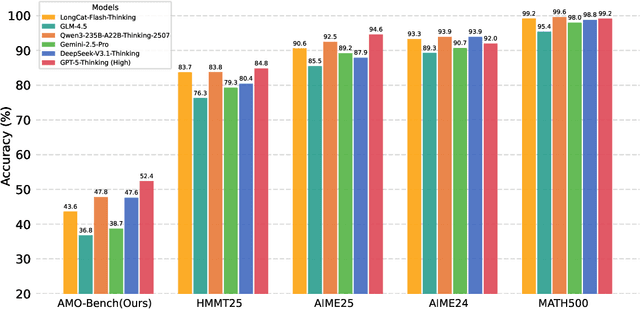
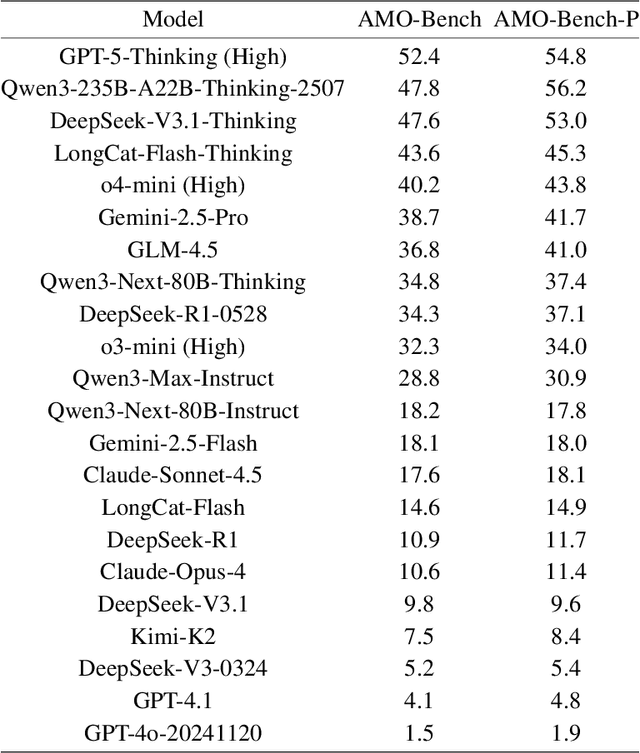

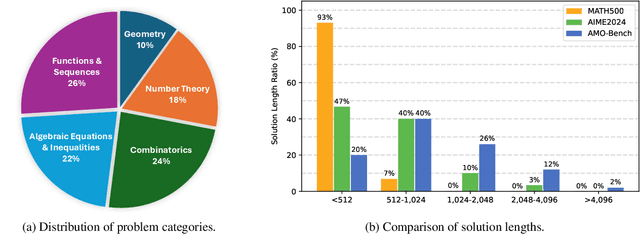
Abstract:We present AMO-Bench, an Advanced Mathematical reasoning benchmark with Olympiad level or even higher difficulty, comprising 50 human-crafted problems. Existing benchmarks have widely leveraged high school math competitions for evaluating mathematical reasoning capabilities of large language models (LLMs). However, many existing math competitions are becoming less effective for assessing top-tier LLMs due to performance saturation (e.g., AIME24/25). To address this, AMO-Bench introduces more rigorous challenges by ensuring all 50 problems are (1) cross-validated by experts to meet at least the International Mathematical Olympiad (IMO) difficulty standards, and (2) entirely original problems to prevent potential performance leakages from data memorization. Moreover, each problem in AMO-Bench requires only a final answer rather than a proof, enabling automatic and robust grading for evaluation. Experimental results across 26 LLMs on AMO-Bench show that even the best-performing model achieves only 52.4% accuracy on AMO-Bench, with most LLMs scoring below 40%. Beyond these poor performances, our further analysis reveals a promising scaling trend with increasing test-time compute on AMO-Bench. These results highlight the significant room for improving the mathematical reasoning in current LLMs. We release AMO-Bench to facilitate further research into advancing the reasoning abilities of language models. https://amo-bench.github.io/
Making Mathematical Reasoning Adaptive
Oct 06, 2025



Abstract:Mathematical reasoning is a primary indicator of large language models (LLMs) intelligence. However, existing LLMs exhibit failures of robustness and generalization. This paper attributes these deficiencies to spurious reasoning, i.e., producing answers from superficial features. To address this challenge, we propose the AdaR framework to enable adaptive reasoning, wherein models rely on problem-solving logic to produce answers. AdaR synthesizes logically equivalent queries by varying variable values, and trains models with RLVR on these data to penalize spurious logic while encouraging adaptive logic. To improve data quality, we extract the problem-solving logic from the original query and generate the corresponding answer by code execution, then apply a sanity check. Experimental results demonstrate that AdaR improves robustness and generalization, achieving substantial improvement in mathematical reasoning while maintaining high data efficiency. Analysis indicates that data synthesis and RLVR function in a coordinated manner to enable adaptive reasoning in LLMs. Subsequent analyses derive key design insights into the effect of critical factors and the applicability to instruct LLMs. Our project is available at https://github.com/LaiZhejian/AdaR
MUSE: MCTS-Driven Red Teaming Framework for Enhanced Multi-Turn Dialogue Safety in Large Language Models
Sep 18, 2025Abstract:As large language models~(LLMs) become widely adopted, ensuring their alignment with human values is crucial to prevent jailbreaks where adversaries manipulate models to produce harmful content. While most defenses target single-turn attacks, real-world usage often involves multi-turn dialogues, exposing models to attacks that exploit conversational context to bypass safety measures. We introduce MUSE, a comprehensive framework tackling multi-turn jailbreaks from both attack and defense angles. For attacks, we propose MUSE-A, a method that uses frame semantics and heuristic tree search to explore diverse semantic trajectories. For defense, we present MUSE-D, a fine-grained safety alignment approach that intervenes early in dialogues to reduce vulnerabilities. Extensive experiments on various models show that MUSE effectively identifies and mitigates multi-turn vulnerabilities. Code is available at \href{https://github.com/yansiyu02/MUSE}{https://github.com/yansiyu02/MUSE}.
Instance-level Randomization: Toward More Stable LLM Evaluations
Sep 16, 2025



Abstract:Evaluations of large language models (LLMs) suffer from instability, where small changes of random factors such as few-shot examples can lead to drastic fluctuations of scores and even model rankings. Moreover, different LLMs can have different preferences for a certain setting of random factors. As a result, using a fixed setting of random factors, which is often adopted as the paradigm of current evaluations, can lead to potential unfair comparisons between LLMs. To mitigate the volatility of evaluations, we first theoretically analyze the sources of variance induced by changes in random factors. Targeting these specific sources, we then propose the instance-level randomization (ILR) method to reduce variance and enhance fairness in model comparisons. Instead of using a fixed setting across the whole benchmark in a single experiment, we randomize all factors that affect evaluation scores for every single instance, run multiple experiments and report the averaged score. Theoretical analyses and empirical results demonstrate that ILR can reduce the variance and unfair comparisons caused by random factors, as well as achieve similar robustness level with less than half computational cost compared with previous methods.
HKD4VLM: A Progressive Hybrid Knowledge Distillation Framework for Robust Multimodal Hallucination and Factuality Detection in VLMs
Jun 16, 2025Abstract:Driven by the rapid progress in vision-language models (VLMs), the responsible behavior of large-scale multimodal models has become a prominent research area, particularly focusing on hallucination detection and factuality checking. In this paper, we present the solution for the two tracks of Responsible AI challenge. Inspirations from the general domain demonstrate that a smaller distilled VLM can often outperform a larger VLM that is directly tuned on downstream tasks, while achieving higher efficiency. We thus jointly tackle two tasks from the perspective of knowledge distillation and propose a progressive hybrid knowledge distillation framework termed HKD4VLM. Specifically, the overall framework can be decomposed into Pyramid-like Progressive Online Distillation and Ternary-Coupled Refinement Distillation, hierarchically moving from coarse-grained knowledge alignment to fine-grained refinement. Besides, we further introduce the mapping shift-enhanced inference and diverse augmentation strategies to enhance model performance and robustness. Extensive experimental results demonstrate the effectiveness of our HKD4VLM. Ablation studies provide insights into the critical design choices driving performance gains.
OIBench: Benchmarking Strong Reasoning Models with Olympiad in Informatics
Jun 12, 2025



Abstract:As models become increasingly sophisticated, conventional algorithm benchmarks are increasingly saturated, underscoring the need for more challenging benchmarks to guide future improvements in algorithmic reasoning. This paper introduces OIBench, a high-quality, private, and challenging olympiad-level informatics dataset comprising 250 carefully curated original problems. We detail the construction methodology of the benchmark, ensuring a comprehensive assessment across various programming paradigms and complexities, and we demonstrate its contamination-resistant properties via experiments. We propose Time/Space Completion Curves for finer-grained efficiency analysis and enable direct human-model comparisons through high-level participant evaluations. Our experiments reveal that while open-source models lag behind closed-source counterparts, current SOTA models already outperform most human participants in both correctness and efficiency, while still being suboptimal compared to the canonical solutions. By releasing OIBench as a fully open-source resource (https://huggingface.co/datasets/AGI-Eval/OIBench), we hope this benchmark will contribute to advancing code reasoning capabilities for future LLMs.
NTIRE 2025 challenge on Text to Image Generation Model Quality Assessment
May 22, 2025Abstract:This paper reports on the NTIRE 2025 challenge on Text to Image (T2I) generation model quality assessment, which will be held in conjunction with the New Trends in Image Restoration and Enhancement Workshop (NTIRE) at CVPR 2025. The aim of this challenge is to address the fine-grained quality assessment of text-to-image generation models. This challenge evaluates text-to-image models from two aspects: image-text alignment and image structural distortion detection, and is divided into the alignment track and the structural track. The alignment track uses the EvalMuse-40K, which contains around 40K AI-Generated Images (AIGIs) generated by 20 popular generative models. The alignment track has a total of 371 registered participants. A total of 1,883 submissions are received in the development phase, and 507 submissions are received in the test phase. Finally, 12 participating teams submitted their models and fact sheets. The structure track uses the EvalMuse-Structure, which contains 10,000 AI-Generated Images (AIGIs) with corresponding structural distortion mask. A total of 211 participants have registered in the structure track. A total of 1155 submissions are received in the development phase, and 487 submissions are received in the test phase. Finally, 8 participating teams submitted their models and fact sheets. Almost all methods have achieved better results than baseline methods, and the winning methods in both tracks have demonstrated superior prediction performance on T2I model quality assessment.
ViC-Bench: Benchmarking Visual-Interleaved Chain-of-Thought Capability in MLLMs with Free-Style Intermediate State Representations
May 20, 2025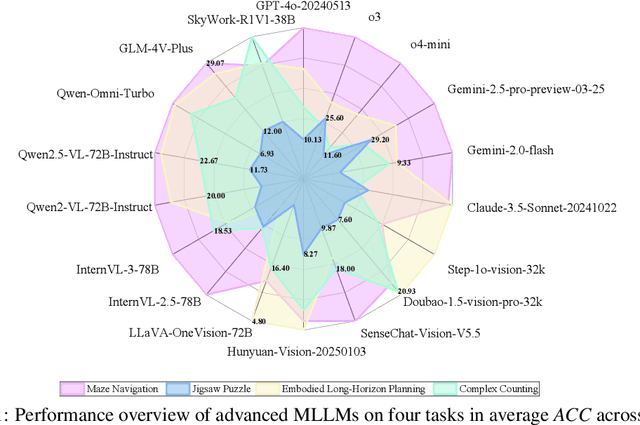

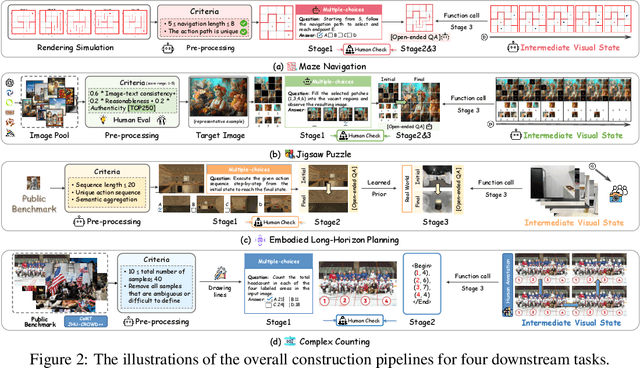
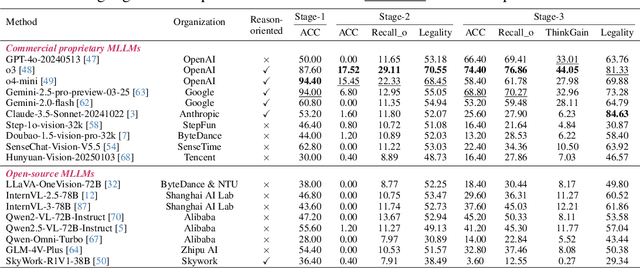
Abstract:Visual-Interleaved Chain-of-Thought (VI-CoT) enables MLLMs to continually update their understanding and decisions based on step-wise intermediate visual states (IVS), much like a human would, which demonstrates impressive success in various tasks, thereby leading to emerged advancements in related benchmarks. Despite promising progress, current benchmarks provide models with relatively fixed IVS, rather than free-style IVS, whch might forcibly distort the original thinking trajectories, failing to evaluate their intrinsic reasoning capabilities. More importantly, existing benchmarks neglect to systematically explore the impact factors that IVS would impart to untamed reasoning performance. To tackle above gaps, we introduce a specialized benchmark termed ViC-Bench, consisting of four representive tasks: maze navigation, jigsaw puzzle, embodied long-horizon planning, and complex counting, where each task has dedicated free-style IVS generation pipeline supporting function calls. To systematically examine VI-CoT capability, we propose a thorough evaluation suite incorporating a progressive three-stage strategy with targeted new metrics. Besides, we establish Incremental Prompting Information Injection (IPII) strategy to ablatively explore the prompting factors for VI-CoT. We extensively conduct evaluations for 18 advanced MLLMs, revealing key insights into their VI-CoT capability. Our proposed benchmark is publicly open at Huggingface.
 Add to Chrome
Add to Chrome Add to Firefox
Add to Firefox Add to Edge
Add to Edge